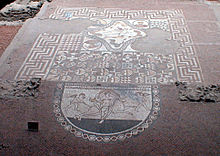Roman mosaics in Britain
The Roman mosaics in Britain are among the most characteristic creations of Roman-British art. More than 500 mosaic floors are known to date, many of them from villas and dating back to the fourth century. 200 of them are decorated with figural scenes. They prove the wealth of the province of Britain in late antiquity .
First to third century
The earliest Roman mosaics come from the Palace of Fishbourne in the south of the island. The floors of the earliest phase of this building date from 75 to 80 AD. They are black and white mosaics with geometric patterns. The style of the mosaics indicates that they were made by a master from Italy . Other first-century mosaics in Britain are rare. In Eccles, Kent , in a palatial villa, there was a colored mosaic depicting a gladiatorial fight . The mosaic also dates to the first century.
In the second century, mosaics are widespread and mostly concentrated in the cities of the province. Numerous examples come from Verulamium . The mosaics are now usually multicolored. Figurative representations are popular and are often located in a central field in the middle of the floor. This first heyday dates mainly between the years 150 to 200 AD. The quality of the work varies, but the figures rarely reach the level of Gallic or Italian work. As a rule, the figures appear schematic and the figures are clumsy, especially when it comes to the three-dimensional form. There are hints of light and shadow without really creating a three-dimensional impression.
Few mosaics can be dated to the third century. The time of crisis in the Roman Empire was also felt in Britain.
Fourth century
The real heyday of Roman mosaics in Britain was the fourth century. It was mainly the villas that were decorated during this time . This also reflects the declining importance of cities during this period.
The dating of the mosaics within the fourth century presents numerous difficulties. The best clues are the cases in which coins were found underneath a mosaic, other clues are conversions in which floors were built over and the conversion phase can be easily dated. Such cases are rare, however, so that one usually has to be satisfied with a general date of the fourth century when dating.
The majority of the mosaics only have geometric and ornamental patterns. These include the frequent depiction of a cantharus , an ancient drinking vessel with spirally wound handles, which is often surrounded by ornamental flower and leaf garlands. The figurative scenes come to a large extent from Greco-Roman mythology. There are depictions of deities, scenes from legends such as the Aeneid with the depiction of Dido and Aeneas, or mythological scenes such as the robbery of Europa . The portrayal of the singer Orpheus was very popular. Early Christian depictions are rather rare, as are scenes from everyday life. Above all, gladiators, circus scenes and hunting scenes should be mentioned here. Representations of the four seasons and of erotes were also popular. All of these motifs come from the Greco-Roman world, Celtic influences cannot be determined.
Stylistically, the figures are usually kept simple. There are few hints of space or light and shadow. The figures often seem awkward. A few mosaics also bear inscriptions, these are classic literary quotations, an artist's signature or the name of a charioteer.
By comparing motifs and iconography, different schools or workshops could be distinguished. The best known is the Corinian school operating in Corinium Dobunnorum . Another workshop operated in Durnovaria and is called the Durnovarian Group .
The end of Roman mosaic art in Britain likely came around the beginning of the fifth century when Roman troops withdrew from the island.
exploration
The first Roman mosaics in England were found and drawn as early as the 16th century. A first treatise on the subject comes from John Aubrey , who devoted a chapter to the mosaics in his manuscript Monumenta Britannica . In the following time, mosaics were found and drawn again and again, although many of them are lost today, so that the drawings are of particular value today. Above all, Samuel Lysons (1763–1819) should be mentioned here, who had precise, colored drawings of numerous mosaics made. Numerous mosaics were also found in the 19th century and often published in detailed drawings. The discovery of photography initially brought about a decline in research and above all in documentation. The mosaics were often only photographed, these recordings often only showing sections of an entire floor and not being colored. The mosaics that were found in the twentieth century are mostly still preserved today, but were often not adequately documented, so that even more recently it has happened that mosaics were poorly or poorly documented, destroyed.
See also
literature
- David John Smith: The Mosaic Pavements , in: Albert Lionel Frederick Rivet (Eds.): The Roman Villa in Britain , Routledge & Kegan Paul, London 1969, pp. 71–125.
- David S. Neal: Roman mosaics in Britain. An introduction to their schemes and a catalog of paintings. Society for the Promotion of Roman Studies, London 1981.
- Patricia Witts: Mosaics in Roman Britain , Stroud 2005, ISBN 0-7524-3421-7 .
- David S. Neal, Stephen R. Cosh: Roman mosaics of Britain Volume 1: Northern Britain, incorporating the Midlands and East Anglia , London 2002, ISBN 0-9537845-2-5 .
- David S. Neal, Stephen R. Cosh: Roman mosaics of Britain , Volume 2: South-West Britain , London 2006, ISBN 0-9547916-1-4 .
- David S. Neal, Stephen R. Cosh: Roman Mosaics of Britain , Volume 3: South-East Britain , The Society of Antiquaries of London, London 2009, ISBN 978-0-85431-289-4 .
- David S. Neal, Stephen R. Cosh: Roman Mosaics of Britain , Volume 4: Western Britain , The Society of Antiquaries of London, London 2010, ISBN 978-0-85431-294-8 .





